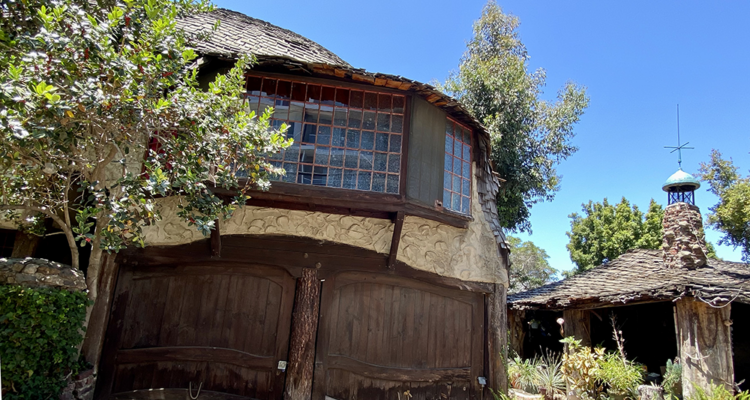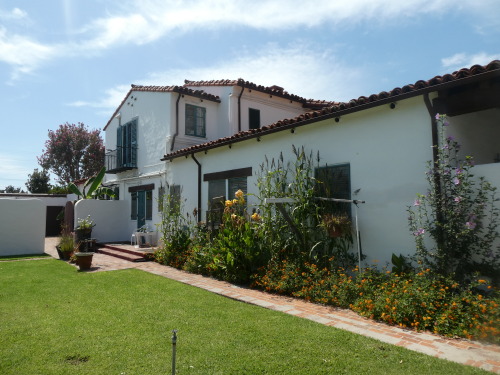
Blog
Easements Demystified
December 19, 2019
Saving historic places rarely takes a one-size-fits-all approach; the Conservancy most often applies a different set of tools and strategies in each case. While much of our work typically involves years of effort nudging a project toward a preservation outcome, the best way to permanently save a historic resource is through a conservation easement. An easement is a legal agreement recorded on the title of the property that runs in perpetuity with the deed, regardless of the owner.
EASEMENTS IN A NUTSHELL
An easement is a private or partial legal interest transferred by a property owner to a qualified preservation nonprofit organization (in this case, the Conservancy) or government entity. The owner continues to own the property but transfers the specific set of rights represented by the easement to the easement-holding organization. As the easement-holder, the Conservancy is responsible for monitoring the property’s condition, reviewing any proposed changes to the property, and ensuring that any alterations conform to the Secretary of the Interior’s Standards for Rehabilitation (nationally recognized and widely used preservation standards).
Since accepting our first conservation easement in 1981, we have worked to ensure long-term protection and preservation for some of the most visible landmarks throughout Greater Los Angeles. Easements come to us in various ways, sometimes as a result of an advocacy effort. When the 1931 Pellissier Building and Wiltern Theatre faced demolition in 1979, the Conservancy helped to delay demolition by negotiating with the City, providing a feasibility study for alternative use, and holding a massive public rally. Backed by hundreds of supporters, the effort lead to the Conservancy’s first major victory. Developer Wayne Ratkovich rescued the building by purchasing it, completing an extensive sensitive restoration, and donating an easement on the property to the Conservancy.
WHY PEOPLE DONATE EASEMENTS
Many owners of historic landmarks look to conservation easements because they provide even stronger protection than traditional landmark or historic district designation. Many local preservation ordinances allow for only a delay, not denial, in the demolition of a designated landmark, as is currently the case in Los Angeles. Easements also are not subject to political issues that can threaten designated properties.
While many owners have the best intentions and wishes for their historic properties, future owners may not share the same values. As we have seen all too often, it is risky to assume that future owners will continue to preserve a historic structure, even if they voice such intentions. Residences, especially from the mid-twentieth-century, can be particularly vulnerable. As original or longtime owners move or pass away, the properties they stewarded for decades can be seen as dated, in need of too much repair, or simply inferior to the development potential of the lot.
An easement requires both current and future owners to properly maintain the property, and it provides a legal means of enforcement. Because easements are recorded on the title for the property and run in perpetuity, regardless of the owner, they serve as a vital tool to protect historic places for future generations.
Some people donate easements to take advantage of potential economic incentives. For qualified projects, an owner may be able to take a charitable contribution deduction from their federal income taxes for the value of the conservation easement, if the contribution meets Internal Revenue Service requirements.
The value of an easement for the purposes of the federal tax deduction varies by property, based on a qualified appraisal performed by a qualified appraiser. The property’s development potential can also affect the easement value. For instance, properties that theoretically could otherwise be redeveloped at a much higher density might have a higher value of the easement deduction. Anyone donating an easement should obtain solid tax and legal advice specific to their circumstances.
Conservation easement properties are generally privately owned by individuals or organizations who wish to see them preserved, not harmed, and are outstanding stewards. Though ready if necessary, the Conservancy has not yet needed to take legal action to defend and enforce any of our easements.
EVERY EASEMENT TELLS A STORY
Most of the Conservancy’s easements cover only the exterior of protected buildings, typically only the façades. Depending on the owner’s intent and the particular property, an easement might be much more detailed and specific. The Lawrence and Martha Joseph Residence and Apartments is a good example. Built between 1946 and 1970, this is one of the most significant examples of Storybook architecture in L.A. Nicknamed “the Hobbit Houses,” the eclectic cottages were designed by Lawrence Joseph, a former Walt Disney Studios artist who later worked on classified aircraft design projects for the Lockheed “Skunk Works” facility in Burbank. The Conservancy holds an easement protecting the original landscaping, as well as the exterior façade and interior features created by Joseph.
Not all of the Conservancy’s easement properties are located in L.A. In Downey, the Conservancy holds a façade easement on the Casa de Parley Johnson, a two-story Monterey-style residence designed and built in 1927 by noted architect Roland Coate. Built for Parley Johnson, a prominent local citrus farmer, and his wife, Geline “Gypsy” Johnson, the home and its gardens were originally situated in the center of the Johnsons’ fifty acres of orange groves. Surrounded by whitewashed walls, the house features balconies and patios integrating the interior spaces with the outdoors. Parley Johnson’s widow Gypsy lived in the house until her death in 1986, when it was bequeathed to the Assistance League of Downey.
Each of the Conservancy’s easement properties has its own unique story and significance. Thanks to the protection provided by easements, these stories can continue to inspire us for years to come. To see photos of these properties and learn about others, and to learn more about the Conservancy’s conservation easement program, visit laconservancy.org/easements.

